Archive for category Past issues
Kalaa Arpan:  Babeena Sharma’s Pleasant Recital
Posted by admin in January 2017 on December 28, 2016
By Jayashri Phanse
e-mail: jsphanse560@hotmail.com
On Saturday, September 10, under the auspices of the S.V.Temple, Babeena Sharma offered Kalaa Arpan, a semi classical Hindustani vocal recital. It was indeed a refreshing change for the Temple’s audience used to only South Indian classical art forms in recent times.

Babeena, after the customary Ganesh Vandana, chose Kasturi tilakam lalata patale… in Madhuvanti, a verse from Naaraayaneeyam, a 16th century work by Narayana Bhattathri of Kerala, to begin the concert. The verse describing Krishna’s ever-beautiful form, took the audience along to visualize the adoration of Gopis for Krishna with all his adornments. This was followed by Ullanghe Sindho in the raag Bhatiyar dedicated to Hanuman, who, in Ramayana, crossed the hundred yojanas of the ocean to find Sita in Lanka.
A disciple of Pandita Tripti Mukherji, Babeena shared an amusing anecdote tracing the origin of the verse in Mukherji’s interactions with Pandit Jasrajji, the Bade Guruji for all the disciples of Guru Mukherji. Babeena mellifluously traversed through the raga to give the audience a meditative experience of a bairagi.
After doing adequate justice to the Great Miya Tansen’s composition Teri Gati in raag Malkauns, Babeena presented another challenging masterpiece, Mata Kalika in raag Adana, describing Kali as the Supreme Mother. In the next piece, Dwadasha Jyotirlinga in raag Mangal Bhairava, Babeena musically described Shiva, the other half of the Ardhanareeshwara form.
With Venky Sharma, Babeena’s husband as the Master of Ceremony and their children Ashutosh and Kamakshi on vocal support, this piece and the following became a nice family presentation.
The next two were devotionals on Krishna. The first, Laal Gopal – a Haveli Sangeet –from Western India, depicted the colorful Holi festival. The second was a popular Purandara Dasa Devaranama – Jagadodhdharana in the Raag Kapi. In her lilting voice Babeena successfully painted the picture of mother Yashoda blissfully playing, sometimes remonstrating little Krishna, all this in total oblivion of the fact that she has the Supreme Lord in her arms. Babeena choosing the popular number and rendering it in the Karnatic style was well appreciated by her audience.
Asatoma sat gamaya, which was next, was Babeena’s dedication to her mother and first Guru, Behroze Chatterji, whom she considers an eternal source of inspiration. In the concluding piece, Om Namo Bhagavate Vasudevaya in raag Bhimpalasi, the artist invited the audience to join in the devotional chant maintaining. All through the evening, Babeena was confident, and came across as dedicated while she created a spiritual meditative mood.
Aqeel Bhatti on the Tabla provided percussion support while Arif Mani accompanied the artiste on the harmonium.   ♣
The Blue Sweater in My Drawer
Posted by admin in January 2017 on December 28, 2016
Samar Sinharoy, Monroeville, PA
e-mail: Â samar.sinharoy@gmail.com
Note:  Samar spent most of his working life as a research scientist at the now-defunct Westinghouse Science and Technology Center in Churchill. Post-retirement, he taught physics for five years at Robert Morris University. He spends his time socializing at the gym, reading, visiting his kids and grandkids, traveling, and taking Osher learning program courses at Pitt.
 There is a blue sleeveless sweater in my dresser drawer. I have had it for over half a century. It has a beautiful design; but with the color faded, the wool looks frazzled. I don’t use it anymore. Nevertheless, occasionally I take it out, just to look at it fondly remembering the person — my ma — who knitted it, and simply put it back.
There is a blue sleeveless sweater in my dresser drawer. I have had it for over half a century. It has a beautiful design; but with the color faded, the wool looks frazzled. I don’t use it anymore. Nevertheless, occasionally I take it out, just to look at it fondly remembering the person — my ma — who knitted it, and simply put it back.
I  grew up in Puri, a coastal city on the Bay of Bengal in Odisha, India. It never got too cold there, so all we needed in winter was either a thin shawl or a sleeveless sweater. We were five siblings in our house. The sixth one was already out of the house — in Kolkata.
Although my father was the breadwinner, my mother was the glue for the family. She did all the cooking using a coal-burning stove that had to be fired up each morning. With no refrigerator, fresh food had to be cooked every day. She worked hard all day. Yet she never complained, and was always pleasant. She was an avid reader and inspired us to read. She loved music, played on the harmonium, and taught my two sisters vocal music.
She also spent a considerable amount of time sewing and knitting. I was in the second year of college in 1958, when she knitted this particular blue sweater for me. I loved it, wearing it all winter long.
I brought the sweater with me when I came to the U.S. in 1966 to go to graduate school in New York City. After my PhD, did a post-doctoral stint in Germany, and came back in 1975 for a second post-doc assignment at the University of Missouri-Rolla. That is where I met my wife Semahat, a lovely young woman from Turkey, who had arrived the previous year at Rolla for her MS in Metallurgy. We got married in 1976 and moved to Pittsburgh in 1978, where both of us started working for Westinghouse. Like many other immigrant Indians, we bought a house in the suburbs, two cars, and had a daughter and a son. Through these transitions, I kept using my blue sweater.
Now retired, time is catching up on me. The kids live far away in Atlanta, not as far away as I was from my parents. My wife of nearly forty years of marriage passed away in her sleep a few years ago.
Thinking about her, I realize that she had some of the same qualities that made my mother so special. Maybe subconsciously, I was looking for a person with those qualities: my wife was a great cook, an avid reader, and a knitter to boot, among many other things. She knitted a green, long-sleeve turtleneck sweater for me, which I treasure.
My blue sweater is too old to wear any more, but I am still saving it as a reminder of a time gone by, of a less complicated era.
We as parents hand over to our kids things from our era, like the blue sweater I received from my ma. I wonder, a few decades from now, will my kids too, in their retirement, brood over the knick knacks we give them, as I do now.  ♣
Sunflower: A Short Film on Aging & Memories
Posted by admin in January 2017 on December 28, 2016
By Premlata Venkataraman
e-mail: Â ThePatrika@aol.com
The day after Black Friday saw the Pittsburgh screening of Sunflower, a 15-minute short film with our own Juginder Luthra debuting in films in his semi-retirement. The film, directed by 23-year old Peter Ferris Rosati, was screened at the Row House Theater in Lawrenceville.
 A sensitive film about the elderly selectively nurturing their memories — and haunted by them — is the theme of this short film. The sunflower with its many pods is an allegory for the elderly selectively recalling events retained in their memories. Each pod is a sachet of memory retained.
A sensitive film about the elderly selectively nurturing their memories — and haunted by them — is the theme of this short film. The sunflower with its many pods is an allegory for the elderly selectively recalling events retained in their memories. Each pod is a sachet of memory retained.
The only character in the film, a 70-plus year old man, is living all by himself in a dingy and grimy apartment; he remains nameless and utters not a single word of dialog.
He cherishes the sunflower plant in his backyard he has carefully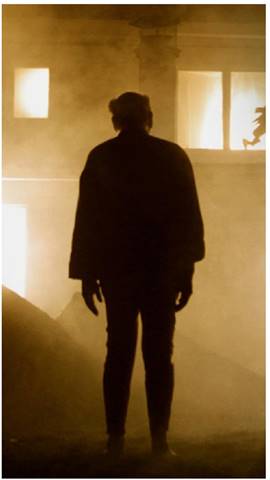 kept alive, the same way he cherishes his memories. But the ravages of time, allegorically portrayed by a large made-up bird that looks like a raven, repeatedly seeks to destroy the flower — eventually succeeding in doing so — in spite of the best efforts of the elderly man to keep it alive. How it affects the old man is the grand finale.
kept alive, the same way he cherishes his memories. But the ravages of time, allegorically portrayed by a large made-up bird that looks like a raven, repeatedly seeks to destroy the flower — eventually succeeding in doing so — in spite of the best efforts of the elderly man to keep it alive. How it affects the old man is the grand finale.
Luthra, without the benefit of spoken words, brings out the intense anguish of the character waging a losing battle against time. He portrays anger, fear, self-pity, and helplessness as he tends to the plant, with occasional flashbacks of memories haunting him.
Talking to me after the screening, Â Luthra told me, the 15-min film was chiseled out of nearly seven hours of videotape footage.
The young director Peter Ferris Rosati — he is still in his early 20s — shows maturity in sensitively bringing out from Luthra’s nameless character how the elderly hold on to their memories, when life around them already has fallen apart.   ♣
. Ha !
Posted by admin in January 2017 on December 28, 2016
By K S Venkataraman
e-mail: Â thepatrika@aol.com
In India, from time immemorial rivers have been used as a metaphor for life’s challenges. Hina-yaanam (literally, the Small Vehicle or Boat) and Maha Yaanam (Big Vehicle or Boat) are Buddhism’s two branches. The Yaanam is for crossing the river of Duhkham (discontentment in life). Samsara sarovar (the sea of life) is the expression used again and again in Dharma-based literature. Teerthankaras (literally, Boatmen Who Help to Cross the River) are great teachers in the Jain tradition helping people to cross the river of life.
River as a metaphor for life in India is entirely understandable since rivers, big-and-small, are everywhere that people need to cross — the mighty Brahmaputra, Sindhu, and Ganga, the erratic Kosi; and the Narmada, Tapti, Mahanadi, Godavari and Krishna, Kaveri, Kaaladi…
So, it is not surprising that the Urdu poets too have used rivers and boats as metaphors in their poetry. Here is a doha (couplet) by Akhbar Allahabadi (1846-1921), sent to us by Harish Saluja, the painter, music lover, film producer/director… :

The difference between old and new ‘light’ (wisdom) is this:
 One can’t find the boat, and the other can’t find the shore.
The “old†and the “new†can be interpreted generationally as the old people and young people in every era; or as Old Wisdom and New Wisdom in the chronological sense.
River-and-boat based themes and motifs have continued to fascinate Indians as we see in popular songs with great lyrics, tuned to melodious folk-tunes and beautifully picturized in films. Here are examples you can access on YouTube:
Asaiyé alaipolé (Tamil):  www.youtube.com/watch?v=ydi-WAnlXfE
Odam nadiyinilé (Tamil):  www.youtube.com/watch?v=Mq3DDO7gNYg
Kari mukhil kaattilé (Malayalam):  www.youtube.com/watch?v=rIfv-KpmN7I
O ré maaji mera saajan he us par:  www.youtube.com/watch?v=5OVFQVNlU1U
O maaji ré (Hindi):  www.youtube.com/watch?v=iD6UvXVyfpI
Majhi baiya jau re (Bengali): Â www.youtube.com/watch?v=-5U9dUpM3vA
In Asaiye Alaipole a boatman is shown ferrying people across a river, singing in a typical folksy tune about people getting tossed hither and tither in the waves of the river, an apt metaphor for a life full of desires and their pursuits.   ♣
Trump vs. Clinton in the Race to the White House
Posted by admin in October 2016 on October 1, 2016
By Kollengode S Venkataraman
This November, millions of voters in the US will ponder which box to check — whether to go with Hillary Clinton, or with Donald Trump, or to simply leave both boxes blank. Sigh! Several expressions describe my dilemma — between the Devil and the Deep Blue Sea, or a rock and a hard place; and Morton’s Fork, all describing situations people face in life with two or more equally bad options. My horizon is already on 2020.
It is unbelievable that the Republican Party, out of the seventeen candidates seeking the nomination — some of them astute pols rooted in the GOP system — ended up electing a neophyte in US electoral politics, Donald Trump. One would think that someone like Trump, a billionaire real estate mogul and casino owner with dicey political and legal business dealings and decisions, would prefer to stay away from the glare of public scrutiny to which presidential candidates get exposed to.
Trump does not have the backing of the GOP heavy weights and elected officials in Congress and the states, not to speak of rich donors, think tank types, and conservative columnists. Many have publicly walked away from him. Only Right-wing talk show hosts on radio and cable TV are rooting for him. Trump’s foolhardy courage is remarkable.

The lack of courage among potential Democratic candidates was pitiful. Fearing the Clinton Machine, nobody had the spine to throw their hat in the ring! If Hillary Clinton wins the election in November, as is predicted by analysts, pundits and bookmakers, she will thank Republicans for giving her Donald Trump as her opponent. With much passion against her among Republicans and many Independents, and many
Democrats lukewarm towards her, Hillary was vulnerable otherwise.
In spite of all the negatives, the billionaire Trump’s bravado on a host of domestic, immigration, foreign policy, and defense issues, as outlandish as they are, resonate well with the working class, mostly white and less educated Americans. It is not hard to understand this.
In the US, only 33% of whites have a bachelor’s degree or better; 90% have a high school diploma or its equivalent. (The stats are worse for blacks and Hispanics). They worked grueling hours in assembly lines, steel mills, fossil fuel industries, and mining/metal industries, but lived comfortably, with all the accoutrements of a good life — two-car garages, boats, vacations… … Globalization and Free Trade wiped out these jobs, and the less educated working class bore the brunt of this brutal transition.
In the 2012 election cycle both the GOP and the Democratic candidates were vying with each other to offer tax cuts for the “middle class.â€Â When pressed to define middle class, they said it was families with an annual income under $250,000! In the US, only around 6% of households have annual income more than $200,000. See below (Source: US Census, 2014):

The latest census data on the US Household income.
That is, political candidates saw themselves as “Middle Class,†even though in terms of their income, net worth, and other intangible assets like access to resources and their wide social and political network, they are the Ruling Elite. With this bizarre definition of middle class, people making between $60,000 and $100,000 can call themselves the “working poor,†while the American median family income is around $55,000.
No wonder, the upper echelons of the GOP establishment was out-of-sync from the problems of the white working class, the base of the GOP. In the primaries, these Republican voters, in disgust, opted for a total outsider, the billionaire Trump, whose rhetorical flourishes resonated with them on many domestic, immigration, military, and trade issues, which they saw as the causes for their anxieties. By electing Trump, they repudiated the GOP establishment.
This does not mean that it is party time for Hillary Clinton and her followers before the elections are over. For one, Hillary Clinton is not in the mold of Golda Meir, Margaret Thatcher, and Angela Merkel, all first-time women leaders of their countries. Meir was the prime minister of Israel (1969-74); Thatcher was the prime minister of the UK during the Reagan years, and Merkel, the current chancellor of Germany. These women became powerful world leaders on their own steam.
Hillary owes her political career to being the wife of Bill Clinton, the popular two-term Democratic president. Without being First Lady with Clinton as her last name, one wonders whether the parochial New York voters would have elected a Hillary Rodham as their US Senator, just two years after she became a legal resident there. Everything in her political career in later years emanates from her being Mrs. Clinton and having stuck with him through the thick and thin of his not entirely stellar lifestyle.
So, Hillary Clinton is the American strain of the Asian archetype of wives and daughters of politicians becoming presidents and prime ministers: Corazon Aquino (Philippines); Sirimavo Bhandaranaike (Sri Lanka); Indira Gandhi (India); Khaleda Zia and Sheikh Hasina (Bangladesh); and Benazir Bhutto (Pakistan). Without their hubbies and daddies, there is no way any of these women could have come to wield so much power.
Hillary Clinton, as President Obama’s Secretary of State, carefully built her image for occupying the White House by visiting over 110-plus countries, honing her image both inside the US and outside. However, nonpartisan — or at least less partisan — observers see her imprint on US foreign policy as lackluster, despite her rock star image.
If people remember the highlights and lowlights of the 2008 Democratic primaries, Hillary Clinton’s campaign against Sen.Barack Obama then contained veiled racist flourishes to win over working-class white voters, something she now vehemently condemns in Trump. But that is politics. Even many women voters are turned off by Hillary Clinton’s negatives.
If Trump ever goes past Hillary in the delegate count and walks into the White House, he too will have to thank his stars that he had Hillary Clinton as his opponent. At least on this score, the two are even.
So, come November, both candidates’ negatives will energize their opponents to bring voters to the polling booth on Election Day. If the weather on that day is bad, only hard core supporters will show up, and anything can happen. In any case, it is unlikely that it would be a landslide victory for Hillary Clinton, either in terms of the popular vote nationwide, or in the delegate count.
That is why it is a choice among Worse, Worse, and Worse, come November. Leaving the box blank is also not a good option. There is, however, one silver lining for both candidates in this scenario: Whoever wins, voter expectation for both is so low that even if their performance is barely a passing grade, people would sigh in relief, “After all, it is not as bad as it could have been!â€Â And their cronies will spin this as their master’s great accomplishment!
Endnote: In this election cycle, with no coattail effect, and with so many negatives for both Hillary Clinton and Donald Trump, candidates for the US House and Senate for both parties are pretty much running on their own. If the anti-establishment mood plays into the voters’ psyche, people may simply vote against sitting members seeking re-election to the US House and Senate. So, the elections to the US Congress will be as important. The US Senate leadership may change hands and in the House, the GOP majority will erode, maybe even evaporate.
We are certainly living in interesting times.  ♣
India in the 2016 Rio Olympics
Posted by admin in October 2016 on October 1, 2016
By Kollengode S Venkataraman
One Indian news item this summer that drew global attention — from the media in Europe, North America, and even China — is why India with its 1.2 billion population does so poorly in the quadrennial summer Olympics. If you Google-search on this topic and read the top 10 news stories, you will get a good idea of why it is so. There was no smirk in these stories. They were simple, straightforward, and matter of fact. In every social group — extended families, ethnic/caste groups, temples, churches, corporations, hospitals, even nation-states — outsiders readily see what is wrong that the insiders do not see, or refuse to acknowledge, or are embarrassed to admit.

Sakshi Malik after winning her Bronze for wrestling in the 2016 Olympics. Look at her gleeful, joyous smile! In the Indian context, Sakshi, like the other winner Sindhu, is not “fair.†But she is not just “lovely,†but gorgeous.
This year, India’s medal count was abysmal, even by Indian standards. The total medal count in the last five Olympics, including the 2016 at Rio are: 1, 1, 3, 6, 2 out of over 700 gold, silver and bronze medals. Only two medals in 2016, one bronze for wrestling, and the other, a silver, in badminton, both won by women. Cherish the irony here, given the macho atmosphere of the Indian sports scene!
Shobha De, the ultimate gossip columnist titillating anglicized Indians, stirred the pot on the India Olympics this year with the tweet, which, in translation read, “Go to Rio, click your selfies, and return empty-handed.†De is the mother of the phrase Bollywood she coined in derision decades ago for the Bombay-based Hindi film industry. Now, Bollywood is mainstream, and has given birth to Lollywood (for Lahore, Pakistan), and Kollywood (Kodambakkam, Tamil), and Mollywood (Malayalam), and Tollywood (Tollygunj, Bangla, and also Telugu).
She was widely berated for her comment. Among the many thoughtful responses to De’s comment, one stood out. I regret not jotting down the name of person. I do not have the exact words. If I can paraphrase his comments, it went something like this:
“Why everybody is piling of the poor performance of the Indian athletes in Rio? For all the money India spends every year and the vast infrastructure it has in national science labs, IITs and IIMs, nobody asks why India’s record is poor in Nobel prizes? And for the 100-plus years of history in the film making, why India’s record is so poor in the Grammys, Emmys and Oscars?â€Â
A valid point, requiring soul searching and serious discussion.
In any case, if you scan the hard copies of any Indian English newspapers, one glaring observation stands out: over 90% of the column inches are taken up by the raw, personality-based political news at the national and state levels; news and gossip about films and film personalities; cricket news; European culinary trends in the Indian Metros; real estate; how Indian techies are ruling the world (?), and fashion.
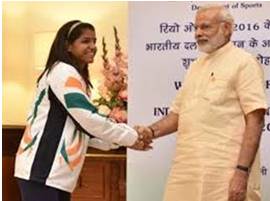
Sakshi malik received by Prime Minister Narendra Modi in New Delhi after her return with the Olympic Medal.
With these items taking up so much oxygen for the greater part of every year, not much is left for anything else. Add to this the Indian ethos of disdain for all physical activities in general.
In many countries, sports & athletics are a serious business with governments pumping in lots of money. They identify youngsters before they are 10, and train them in gymnastics, track and aquatic events, and all others. That is the only way to nurture excellence in sports.Â
However, excellence in sports and athletics is not a priority for the Indian middle class — unless it sees money in it, lots of it, as in cricket. That is how India killed field hockey, a very intense game in which India excelled years ago. If America is obsessed with sports from high school onwards, India is antipodal in its total apathy to school/college sports. The governmental indifference to providing the critical athletic infrastructure and training is only a reflection of the Indian middle class’ apathy for sports.
Besides, nurturing and demanding excellence and weeding out incompetency and under performance are not priorities in today’s India in most facets of human endeavor. Acquiring wealth using any and every way possible, and flamboyantly consuming it are the main pursuits for a big chunk of the Indian middle class. The poor performance of India in Olympics is only a glaring manifestation of this underlying ethos of today’s India. Given this Indian disdain, we need to admire the Indian athletes for their persistence with very few resources and the ridicule of the elites a la Shobha De, when they return with very few medals.
“My journey in Indian Classical Dances†— A Grandmother talks to her Granddaughter
Posted by admin in October 2016 on October 1, 2016
By Moha Desai, Bridgeville, PA
Shrimati Tani Desai, mother of Shambhavi Desai of Bridgeville, grew up in a traditional Nagar Brahmin family in Bombay in the 1950s and 1960s. She had the rare experience of earning her degree in Bharatanatyam from MS University in Baroda in the 1960s by staying in a hostel far away from her home, something that was unusual then. Moha, daughter of Shambhavi and Priyadarshi Desai, talked to her grandma on how she got interested in Bharatanatyam that propelled her to go and earn a degree in the dance form in the 1960s. Â
I had a blessed opportunity of sharing the stage and performing a dance piece with my grand-ma (Tani-ma) earlier this summer. She is now in her 60s. It was a magical experience! In the course of talking to her as her granddaughter, I knew that she earned a degree in Bharatanatyam from the MS University in Baroda. This was in the 1960s. With my own exposure to the Indian classical performing arts tradition in the US, I sat with her to hear from her about her times, her journey in working for a degree in dance and much more. Here are some excerpts:
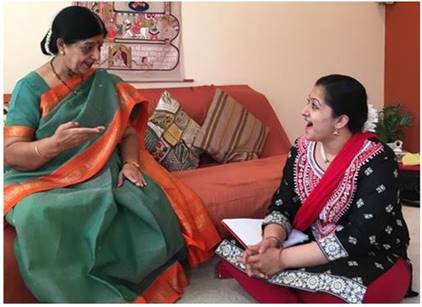
Tani Desai talking to her granddaughter Moha  for this article.
Tani-ma, when you were growing up, what was the society around you, and what was your home environment like?
“I was fortunate to be born and brought up in a large close-knit family in Mumbai with five uncles and aunts. My extended family had an active interest and knowledge about music, dance and dramatics. My father — the eldest in the family — played the flute while other younger uncles and aunts played violin, percussion, Jal Tarang, or were good singers. One of my uncles and brothers were good theatre actors.
“My first guru and uncle, Shri Arjun Desai, trained me in Bharatanatyam and Manipuri dance styles from age five to sixteen. He also introduced me to Guru Devendra Sinha, who taught me Manipuri as well. So, looking back, music and dance had virtually been our way of life while growing up. I was not even conscious about it. It is like a fish not knowing that it is immersed in water.â€
What were the priorities for girls then in general and how did you fit in to those priorities?
“Life during the 1950s and 1960s was definitely not the same for girls as it is these days. Although performing arts were a way of life for me, having a good education was the first priority. I had my schooling in Saint Teresa’s Convent, where discipline and good academics were stressed. I did not get to perform Bharatanatyam or Manipuri at my school like how you all do, but had to do a ‘book-balancing dance’ taught by one of our enthusiastic teachers at school!
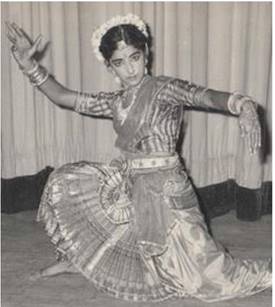
 Tani Desai in her student days.
“Like any other girl, I used to help out with the house-hold chores which included ironing our own clothes, talking care of younger siblings and cousins and so on. All this was in addition to a full-day of school, homework, and dance classes/practices every single day in the evenings; and we used to walk two miles to and from our school! As a senior dance student, I was a part of more than 17 dance ballets in a lead role and other solo performances. I had to manage my time very wisely.
“After I completed my high school, I was really at a crossroads. I loved math and wanted to major in commerce for my Bachelors’ degree at a college in Mumbai while continuing my dance in my free time. Luckily, my parents and uncles recognized my passion for dance, and persuaded me to go to M.S. University, Vadodara and major in Bharatanatyam at the Department of Performing Arts. This was the only University at that time in India that offered degrees and post graduate level courses in dance. I finally went to Vadodara, stayed in a hostel for four years and pursued dance. My parents had done the right thing for me. I had found my home away from home! I eventually did my Masters’ degree here — after I had your mom and your mashi!! It was very unusual at that time!â€
What was the attitude of your fellow neighbors and acquaintances?
“The attitude of the people was mixed. Many of our acquaintances were happy for me when I chose to go to Baroda for majoring in dance- but many others raised their eyebrows at the fact that a young girl from a Nagar Brahmin family was 1) leaving the city, 2) staying in a hostel, and 3) then pursuing dance as against other more conventional areas of studies. This did not dampen my spirits but instead helped me to stay focused and determined.â€
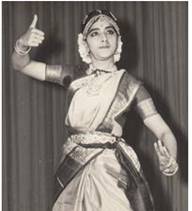
In her prime during a recital.
“Your nanu was fully aware of my passion for dance right from Day-1. He has always been supportive of my interest at every stage of my pursuit.  Without his support and understanding, I could not not have done anything in pursuing dance.  However, it took quite a while for me to persuade my father-in-law to pursue my interest in dancing. I am very happy to tell you, eventually, he was the one who accompanied me for my masters admission.  Mind you, this was after my two daughters started going to school. My mother-in-law was always happy with my interests.  I was very fortunate. “
“The curriculum for the Bachelors’ of Performing Arts (BPA) — formally known as Bachelors in Music (B.Mus.) — is an exhaustive four-year degree course that is divided into theory and practical in each year. It includes all important aspects of Natyashastra, Abhinaya Darpana, Bharatarnava, covering the basics of music, dramatics, and the study of all other classical dance styles, folk dances of India, as well as western/modern dance theories and dances of Southeast Asia. The practical included from the basic adavus to full Margams with training in the Tala system and Nattuvangam. The syllabus also had other subjects like Cultural History, Aesthetics, English, Psychology, Physics and Economics.â€
At the university, in the Bharatanatyam coursework, and in the practical classes, what was the language they used for teaching?Â
“The official language of teaching was English; but teaching was usually done using a blend of English, Gujarati and Hindi as we had students from all over India and abroad too. Our teachers went to great lengths to explain the Tamil and Telugu terms and translated them as required.â€
What changes did you see in dance over the years?
“ Well, there are many changes — most of them good. My Guru, Smt. Anjali Mehr in Baroda, introduced us to choreographing Padams in other regional languages, in addition to the traditional Tamil and Telugu. Many experimental works had already started in our times, but now they are being accepted with a more open mind than before.
“As long as the basic technique and the signatures of the art form are not compromised, such changes are healthy. What pains me though at times is the rampant commercialization at the cost of creativity. On the brighter side, learning Bharatanatyam or any other classical dance form has become

Desai with her students flanked by her grand-daughter (left) and Shambhavi her daughter, (right).
fairly common in all parts of India and abroad, and by people from every kind of socioeconomic background. That says it all!â€
What keeps you going, Tani-Ma?
“A lot of things! Gratitude, satisfaction and passion. Gratitude towards God, my parents, my husband and my family — that I could pursue dance all my life in spite of many challenges along the way. It gives me immense satisfaction and pleasure that I could pass on the same passion to my three daughters and the third generation as well.
“It is satisfying that I could inspire hundreds of students through my dance institute, Pagrav, over five decades, and hope to do so as long as I can! Dance, like any other art form is a Sadhana (pursuit with a total commitment) to connect directly with God. One has to follow the Three Ds to excel: devotion, dedication and discipline. There are no other shortcuts.†    ♣
Musings on Mother Teresa’s Sainthood
Posted by admin in October 2016 on October 1, 2016
By Kollengode S Venkataraman
On Sunday, September 4, the Vatican ceremonially conferred sainthood on Mother Teresa, based on miracles she is supposed to have carried out in people’s lives. As the Reuters reported (www.tinyurl.com/Bureaucratic-Path-to-Sainthood), the process of conferring sainthood is “more bureaucratic than beatific.†Also read this: www.tinyurl.com/AFP-Story-on-Mother-Teresa. So, we reproduce part of our obituary on Mother Teresa’s death in the October 1997 issue of the Patrika:
“In the midst of Calcutta’s mean streets — it could be the slum of any other city — a European nun working with the poorest and the sickest eventually drew the attention of leaders in India and outside, including those perched in the Vatican. With her global reach, one might even say, many indigenously run nonsectarian relief agencies in India did not get the attention and support even within India.
“Mother Teresa lived among the poorest and sickest in an overcrowded city where whatever infrastructure was there was falling apart. And the revered Mother saw no reason for at least tolerating modern family planning methods that excluded abortion.
 “No doubt, it is noble to give the wretchedly poor dignity at least in their death. An equally noble act is to make… … the uneducated poor, recognize that if they do not have large families, they have better chance of getting their children out of poverty, and society may be able to give citizens dignity not only in death, but in life as well. And it is here that one believes Mother Teresa could have had greater impact.â€
If we do not bring these wretched souls into world in the first place,  there is no need for somebody to save them after all. Poverty, I concede, has many contributing factors. However, for destitute families, such as those in the slums of Kolkata, Manila, Mexico City, Paris, or Detroit, large family is one major contributing factor. The deprivation Mother Teresa saw every living moment staring at her in the Calcutta’s slums did not move her to question Vatican’s edict on family planning. Her loyalty to the Vatican on this point was stronger than her compassion to the human abject poverty-driven suffering she was staring at every moment in Calcutta.
there is no need for somebody to save them after all. Poverty, I concede, has many contributing factors. However, for destitute families, such as those in the slums of Kolkata, Manila, Mexico City, Paris, or Detroit, large family is one major contributing factor. The deprivation Mother Teresa saw every living moment staring at her in the Calcutta’s slums did not move her to question Vatican’s edict on family planning. Her loyalty to the Vatican on this point was stronger than her compassion to the human abject poverty-driven suffering she was staring at every moment in Calcutta.
The Vatican’s intransigence on family planning is astounding, given its global reach. After all, an overwhelming majority of even working class Catholics, not to speak of professional white-collar Catholics worldwide practice family planning, not caring its pastoral injunctions. So, the halo around Mother Teresa’s sainthood is not sublime. It is more like the blemishes we see on the moon.   ♣
Eishan Ashwat’s Pleasant Manch Pravesh Recital
Posted by admin in October 2016 on October 1, 2016
By Shailesh Surti
e-mail:Â shailesh.surti@gmail.com
Pittsburghers have witnessed many Arangetrams by young Indian-American dancers. However, we have not witnessed a Manch Pravesh, the first solo recital of Hindustani classical music by a student after years of learning, marking the student’s beginning of a deeper understanding of the art form. Eishan Ashwat‘s Manch Pravesh recital was on June 18 at the Sri Venkateswara Temple Auditorium.
For a young boy growing up in Pittsburgh with no previous exposure to this music, to pursue vocal music with passion, many stars have to align. Eishan found encouragement from his parents, Shirish and Anuradha Ashwat. They live close to Shambhavi Desai (in the inset), a faculty member of the Pandit

Guru Shambhavi Desai
Jasraj Institute of Music (PJIM). She trains under Guru Pandita Tripti Mukherjee. Shambhavi initiated Eishan into vocal music when he was seven. Later, he learned from Pandita Tripti Mukherjee, following the traditions of the Mewati Gharana.
He practiced for countless hours, sometimes with his Guru Shambhavi and with Shambhavi’s husband Pryadarshi Desai, who plays the harmonium. While preparing for the recital, he had guidance from the Sangeet Martand Pandit Jasraj himself.Â
The recital was in front of invited guests well versed in the nuances of Indian vocal music. Eishan gave a full recital, a total of eight compositions in different genres, starting with a Bada Khayal (Khayal in Persian means imagination) in Raga Madhuvanti set to Vilambit (Slow tempo) Ek Taal. He handled the long and serious Bada Khayal, generally sung by the professionals, with ease and elan.
This was followed by a Chhota Khayal in the same Raga set to Teen Taal. Eishan here introduced some complex taans. He used traditional Bandishes (lyrics) for this Raga with sweet and romantic sentiments. The next item was a Khamaj Thumri a light classical piece in Taal Adha.
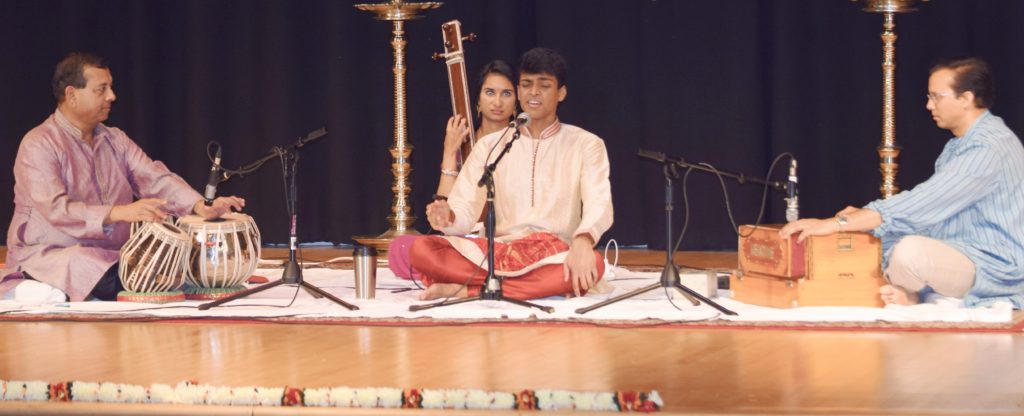
Eishan next rendered a Dhrupad piece, composed by the legendary musician Tansen, in Raga Vasanat set in Chautaal. The Dhrupad style involves an elaborate aalap, followed with layakari with the rhythm. He then rendered a Haveli Sangeet piece, sung in Vaishnava Temples, a Krishna Bhajan set in taal Deepchandi, followed by a Trivat in Raga Kirwani.
Since his family is from Karnataka, he also recited a  Kannada Bhajan of Purandara Dasa in Raga Bibhas. As is customary, the last piece was in Raga Bhairavi, a Meera Bhajan.
It gives me great pleasure to record that Shri Kulkarni on the Tabla, and Dr. Nadkarni on the Harmonium, both veteran musicians in their own standing, provided encouraging support to Eishan.
The program was well received and enjoyed by all. Hopefully, a few youngsters in the audience were persuaded to take up vocal music. Eishan displayed his versatility by singing in seven ragas set in eight different taals, from the ancient genres of Dhrupad to more recent Khayal, Thumri and Bhajan in his first solo recital.
Eishan knows this is just the beginning of his musical journey. With passion, hard work and guidance from his gurus, he will go far.
Eishan is an Eagle Scout. He just graduated from South Fayette High School with high academic honors. He is going to the University of Pittsburgh in a program that will admit him to the medical school. Staying in Pittsburgh will allow him to continue his training under his Gurus.
Pittsburgh is very fortunate to have PJIM-trained dedicated Adya Gurus of the Mewati Gharana. We look forward to more Manch Praveshes in Pittsburgh by young musicians.   ♣
Insightful Introspection in a Vipassana Session
Posted by admin in October 2016 on October 1, 2016
By Asawari Jadhav, Peters Twp., PA
e-mail:Â asawari.jadhav@gmail.com
Asawari Jadhav grew up in Nagpur, India before living for a decade in the UK. She arrived in the US twelve years ago. She now lives in Peters Township with her family and works as a Technical Project Manager for Bombardier Transportation. Her hobbies include playing on the sitar and reading.
Editor’s note: Vipassana is a simple and yet difficult meditation technique practiced and perfected for over 2000 years by the Southern School of Buddhists, the Teravadins, in Myanmar, Sri Lanka, and Southeast Asia. The etymology of Vipassana is in the Sanskrit dhatu (root) drsh meaning “to see, gaze, look.†The prefix vi here means “total†or “comprehensive.†The Vipassana meditation practice is a “comprehensive insight into oneself,†which is easily said, but can be done only with open-mindedness, patience, and practice.
 Over the last few years, I have heard the word “Vipassana†from many believers in the family. The thought of maintaining noble silence for ten days, meditating close to over ten hours each day, disconnecting myself from a device that is almost embedded in my palm, and not being able to run my family, seemed next to impossible.
Over the last few years, I have heard the word “Vipassana†from many believers in the family. The thought of maintaining noble silence for ten days, meditating close to over ten hours each day, disconnecting myself from a device that is almost embedded in my palm, and not being able to run my family, seemed next to impossible.
I had recently tried to question the rat race I was running. I was slowly observing the agitation, anger, an overwhelmed mind, and an impulsive reaction to situations about which I had no control! I finally did end up signing for a ten-day course — over eleven to be precise as the first day is considered Day Zero.
For those who have not heard about Vipassana, I need to tell you that this is more than a course/workshop: students are not allowed to read, write, connect, listen, exercise or take part in any form of entertainment or physical indulgence.
Once I signed up, I realized what I was in for, and the reality had begun to sink in. The thought of getting up at four in the morning and being totally disconnected from the outside world was starting to find every excuse to not join! Fortunately, my earlier wise decision to stick it out for eleven days prevailed over the strong thought to quit. For most of you who have not already checked the Dhamma website, here is a brief summary of the schedule:
Wake up call at 4 a.m. with a one-hour break for breakfast between meditation sessions. A lunch break and rest for two hours and another four-hour meditation session (with breaks). A tea break at 5 p.m. with the last session ending in a discourse by Shri Satya Narayan or S.N.Goenka before retiring 9:30 p.m.
My first day was tolerable, though I found myself dozing off from being in a quiet dark room with long hours of sitting. By the end of the second day, the pain had started to sink in making me very uncomfortable and even the stretching and walks were beginning to be ineffective. My mind was everywhere almost like a spring. Before I could realize it, I was designing fancy comfortable meditation chairs and redoing the window treatments in the Vipassana Center.
On the third day, I was starting to lose it. The OCD (Obsessive Compulsive Disorder) in me had started to organize my memories into stacks. I was kind of spring cleaning the rooms in my brain. Every time I needed a break from cleaning, I would start to pay attention to my breathing. Slowly, I began to question my imagined veracity of the source of my problems, and almost learned a new way of looking at many situations.
Fourth day is when the real “Vipassana†starts. I had already started to adjust and enjoy my own company.
By Day Five, I got into a pattern of changing cushions and positions where I did not get into a torturous physical situation. My mind was craving for the intellectual stimulation, even though craving and aversions were two things I was training my mind to stay away from.
During my breaks I had counted the mugs in the café, read every instruction in the center and estimated the age of the trees! I thought a lot about my family and by the end of Day Five, I was convinced that my husband had forgotten to pick up my thirteen-year-old from camp, and my seventeen-year-old had forgotten his passport for a trip abroad. Panic started to set in. I had created a situation where I really needed to get out. The discourse in the evening revealed that it was normal to have thoughts of quitting.
Day Six and onward got progressively better. I was beginning to feel grounded, calmer, felt less affected by past heartaches. I had almost made peace with my worst enemies.
Day Ten seemed still a long way to go but the bittersweet feeling had started to set in. I had started to accept what was served. Even though the quality of the food was beyond my expectations, I had tried things that I would never even attempt before. I felt lighter inside. I had never recognized the weight of the ego I had carried all along.
Before breaking the Noble Silence on the tenth day, I had started to wonder if my own voice would startle me. I was at peace with my own thoughts. However, I was also curious to verbally connect with the fifteen other women who had shared their energies with me in the meditation room. Women from different walks of life, diverse not only in nationalities but also in age and cultures!
It has been only a few days since the completion of the session, and I am certain I will continue to observe the changes in me from this experience. Here is a summary that I would love to share with you:
Vipassana is not a meditation retreat. It is a process by which you strengthen your mind and increase awareness and practice equanimity. The technique to do this is to observe your breath and bodily sensations without developing a craving or aversion to them. It is simple and difficult at the same time. The focus is to realize that “Change is the only constant thing in life.â€
Every misery arises from the fact that we as humans are constantly reacting to something that is inevitably going to change. It is unrealistic even to hope to drag everybody you are not able to deal with to Vipassana. The need for changes in people should come from within individuals. A ten-day course can just set the direction for you but do not expect to come out with an aura on your head.
Just because you are not paying attention to it, does not mean the world will fall apart! Things still move on when you are not in control. I realized that Peace and Happiness is a State of Mind.
The ten most physically difficult days of my life beat the most exotic locations I’ve visited. So, if you’re ready for introspection, consider attending a 10-day Vipassana session to make an impression on yourself.
Reaching Your Potential Through Teaching
Posted by admin in October 2016 on October 1, 2016
By Archana Janardhanan
e-mail:Â archana913@gmail.com
Archana grew up in the North Hills. After completing her B.A. in English at the University of Michigan in 2004, she worked in New York City for several years before pursuing her master’s degree in Elementary Education at Duquesne University. She now teaches fifth grade at Bradford Woods Elementary School in the North Allegheny School district.
 It is no secret that medicine and engineering are the most popular career choices for Indian-Americans. It makes sense: our parents came here with hopes for a better life for their children. They groomed us to be well-educated to choose life paths which would ensure financial security.
It is no secret that medicine and engineering are the most popular career choices for Indian-Americans. It makes sense: our parents came here with hopes for a better life for their children. They groomed us to be well-educated to choose life paths which would ensure financial security.
However, the world has changed in the intervening years. The goals of second and third generation Indian Americans are not necessarily the same as those of our parents. As the new generations of Indian Americans emerge, I think it may be important for parents to let their children explore other professions in which we may thrive. Young people these days have a heightened awareness and empathy for others that parents need to recognize.
This is why I would like to make the case for teaching. Education is a field in which you are mentally and emotionally challenged each day. There is a level of satisfaction in teaching that no paycheck or prestige could bestow. That satisfaction stems from several aspects of the job.
This year, I had a young student who came to my class at the end of the school year after attending several other schools in the same year. My understanding was that he had behavioral issues which caused some problems with other students.First, let me start with the students. The students are the heart of the profession. They will bring out the best and worst parts of you and thereby allow you to learn some major life lessons.
When he came to my class, he was absolutely wonderful for one week. After that, there was a steady decline in his behavior. He said and did inappropriate things on a daily basis and was even suspended after two weeks. Every time he got in trouble, I spoke to him about his actions and why they were wrong. It seemed I was getting nowhere and my frustration with him was only growing. In the last week of school, I approached him about another transgression.
The night before, I had read an article about how teachers can prevent suspensions by practicing empathy. I decided to put this into practice. When I approached him about what he did, I didn’t speak about his wrongdoing. Instead, I told him I wanted him to be happy. I wanted him to love school and to make friends and to do well in all of his subjects. I told him that I wanted to assist him in practicing behaviors that would help him succeed.
For the first time, he looked me in the eyes when I spoke to him. I will never forget that conversation because I believe it was the first time I connected with him. It made me realize that unless you make an authentic connection with your students — for that matter, with people in general — you cannot have a meaningful impact on them.
Second, your colleagues can be a major source of job satisfaction. When you teach, you are in the trenches every day. You rely on your colleagues for advice, resources, moral support and laughter. Teachers are some of the most wonderful people you will ever meet. They are so used to putting others before themselves that they are usually willing to help you at the drop of a dime. My colleagues have taught me that when you think less of yourself and more of others, you’re happier all around.
The third reason teaching is a worthwhile profession is that you are able to leave your lasting personal imprint on students’ lives. While it is often necessary to adhere to district curriculum standards, once you get used to teaching them, you may use your creativity at your will.
This year, I decided to finish the year with a fun science project. I wanted to make my students aware of the resources all around them and have them incorporate them into our lessons. I decided to arrange a walking field trip to the local community nature reserve. My students took plastic containers and jars and collected various specimens at the reserve.
We then walked back to school and created terrariums (enclosed ecosystems). The students observed the activity in their terrariums each day and kept an ongoing log. For the rest of the year, when they came to science class, they ran to the back of the room to look at their terrariums. I have never witnessed such excitement for a project before this one. We had accomplished our learning objectives while having fun and bringing nature indoors.
While teachers do not make the salary that doctors and engineers make, we have a noble profession all the same. I know that when I look back on my life at the end of it, I will be satisfied and at peace with myself because I have impacted others’ lives in my own way.
If you are trying to finding your life’s path, no matter what age you are, I encourage you to consider teaching. We must bring our best and brightest to this profession because I can think of no one who deserves it more than our children.    ♣
Helping Disadvantaged Girls to Get Education in Rural IndiaÂ
Posted by admin in October 2016 on October 1, 2016
By Dr. Mani Balu, Monroeville, PA
e-mail:Â balus61@mail.com
Dr. Balu, a retired clinical pediatrician, practiced in Uniontown, PA for 23 years, and now lives in Monroeville, PA. He goes to Chennai every winter with his wife Shantha, and helps people afflicted with leprosy, an entirely manageable disease, but with lots of social stigma.
Leprosy is a chronic disease caused by a slow-multiplying bacteria, with five years of incubation period. The disease affects the skin, the peripheral nerves, the mucosa of the upper respiratory tract, and the eyes. This disease is curable with Multi-Drug Therapy (MDT) (Source: WHO). This disease affects in a totally different way healthy young girls in families with elders afflicted with leprosy.
In 2004 I met two dedicated women in Pittsburgh in a conference — Becky Douglas of Atlanta and Padma Venkatraman of Chennai — who work helping leprosy patients. Their work and involvement in helping leprosy patients, who are the most misunderstood, neglected and ostracized people of the world, impressed me immensely. I joined them to start a Mobile Leprosy Clinic in Chengalpattu (near Chennai), which has the biggest leprosy hospital in Asia. Understandably, leprosy patients gravitate towards that town, living in and around the hospital, as they are not allowed to live in the main streets of any town.
While visiting their living quarters, I found out that the girls above 12 or 13 years of age are not allowed to go to school by their parents because there are no lavatories or rest rooms in these schools. With help from some of my friends, we started building rest rooms in these schools. We were very thrilled that this alone increased the number of girls attending schools.
These bright children in these remote villages are denied education because of their parents’ poverty and ignorance on the part of the public, but through no fault of their own. That is the reason for this article.
Most immigrants from India in US are here because of our education, enjoying a comfortable life for ourselves and our children and grandchildren.  In 1956 when I was in medical school in Madras Mr. R. Venkatraman, then Labor Minister of Tamil Nadu (who decades later became India’s president) came to our Medical School. In his address, I remember him telling us this: “Each one of you pay Rs. 200 as your annual fee and the government spends Rs.15,000 on every one of you yearly to run the medical college.†Padma Venkatraman, with whom I now work to help the leprosy patients, is R.Venkatraman’s daughter.
I could not have become a doctor if the annual fee was any higher than
Rs.200! Only the government-subsidized education enabled me to accomplish whatever I did in my life. This is probably true for most of us. In that spirit, I appeal to all of you to help the less fortunate children in India to reach their full potential.
In the past several years I have met many dedicated NGOs in Tamil Nadu helping the needy — AIM (All India Movement) for Seva, The Tamil Nadu Foundation (TNF), Ekal Vidyalaya, Udavum Karangal, to name a few. I am sure there are equally good or better NGOs in other parts of India.
I always feel if each one of us helps our own village where we come from, India will be a better country. Two years ago, I saw a big banner in the Guindy Engineering College in Chennai, once a premium institution in Chennai. It read “EDUCATE A CHILD WHO IS NOT YOURS†Let us do this together.
If you want for further details, contact me at 724 438 8242 (H), 724 322 7175 (C) or e-mail: balus61@mail.com    ♣
My Take on Musical Instruments
Posted by admin in October 2016 on October 1, 2016
by Milun Kumar Jain, Wexford, PA
Milun Jain is starting 7th grade at Marshall Middle School, Wexford. This poem of Milun’s (when his class teacher was Mrs. Phyllis Chvostal) won second place in the Junior Music in Poetry Contest sponsored by Pennsylvania Federation of Music Clubs, Class 1 a couple of years ago.
On a piano I see black ‘n’ white keys
Sure, violin reminds me of a waterfall
The trumpet leads the marching band
While the cello sounds so low
This is my take on musical instruments!
Â
The viola soothes me to sleep
The double bass can wake me up
The flute evens the hills and valleys
And the guitar makes me rock and roll
This is my take on musical instruments!
Â
The drums appear to be in a war
While the saxophone plays real loud
The harp vibrates my arm and body
The triangle shakes my heart and mind
This is my take on musical instruments!
Â
As I strike the xylophone with the mallet
The bagpipes take me to Scotland
As grunt I am as the harmonica
Happy-go-lucky I go with the clarinet
This is my take on musical instruments!
Â
I can use the trombone like a telescope
And the tuba buzzes like butterflies
Through the maze-like tubing of the horn
My whistle goes loud and clear
This is my take on musical instruments!    ♣  Â
More on Tayir, Dahi, Mosaru, or Perugu
Posted by admin in October 2016 on October 1, 2016
By Kollengode S Venkataraman
The write up in the last issue for making authentic tayir (dahi, mosaru, or perugu) had surprising reader responses. It was a good point for conversation for me with friends in social gatherings, much to the chagrin of my wife. More importantly, I received e-mails from readers enquiring how they can get the starter tayir. A couple of them even came to my place to get the starter tayir. They made the original stuff at home, carefully following the instructions. They were pleased with the outcome.
One reader from the American mainstream was surprised that it is so easy to make this at home. She commented that the one she made at home tasted much better than the standard Dannon fare from grocery stores.
By now, tayir and its other Indian variants are common words for our readers. So I will no more italicize them going forward.
One reader was so impressed with the tayir he made at home that he enquired the shelf-life of the starter tayir, if he goes on vacation. As a matter of fact, I was away for 2 weeks in July-August. I kept the starter tayir in a small container in the refrigerator, making sure that the starter tayir is filled to the brim of a container, and the container was closed with an air-tight lid. When I returned from my vacation, the starter tayir was well preserved in its original condition. When I made a fresh batch of tayir, it came out just perfect. Note: If the container is partially filled and closed with a lid, the trapped air in the container may spoil the starter tayir.
Usha Gowda of Monroeville, who is originally from Karnataka, is one of my friends. She suggested this improvement for making mosaru (the Kannada term for tayir): After adding the starter stuff to the milk that is boiled-and-cooled to room temperature, put a small piece of dry red chilly into the vessel and gently stir it and let it sit. Some phytochemical in the red chilly accelerates the fermentation and the mosaru is ready in 5 to 6 hours; it sets also a little thicker, and slices better. Indian green chilly also works just fine.
Finally, an e-mail came from my demanding English teacher at the engineering school where I took a course in writing at the behest of my professor. I am eternally thankful to him for asking me to take the course, and to the demanding teacher for sensitizing me to the nuances of writing for different audiences. She, now in retirement, is in our mailing list. I am one student of hers, maybe her only student, to edit and publish a community magazine. She enjoyed the tayir story, which made her recall her rips to India decades ago. Her letter appears on the next page.
Separately, very perceptively, she also said this: Regarding your comment about the tayir starter, yes, the difference in yogurts around the world is always in the starter. Someone should do a study about the role that plays in a country’s food culture and unique gestalt of each cuisine!
Note: gestalt, a German word, refers to something that is made of many parts and yet is somehow more than or different from the combination of its parts; broadly, the general quality or character of something.
A Letter to the Editor On the Story on Tayir
Dear Editor Venkat:
Enjoyed your article on your adventures making tayir. I have always regretted not getting to Kerala during the time I spent in India in 1970 — but I did travel in the eastern portion of South India.
I loved, loved, loved the dosas and also idlis with coconut chutney. Also, the curries served on a banana leaf. The only reprise of any of these I’ve encountered was in Berkeley in the late 1970s or early 1980s when a tiny grandmother made fantastic dosas in a tiny restaurant space in an arcade of many small shops and eateries. Heavenly … … as long as it lasted. No idlis, though. So your article brought all this back. Lovely memories.
Best wishes,
Charlene Spretnak, Professor Emerita, Ojai, California   ♣
A Jain Sannyasi’s Radical Advice for Addressing the Gender Ratio in Northern India
Posted by admin in October 2016 on October 1, 2016
By K S Venkataraman
The Digambar (literally, sky-clad) Jain Sannyasi (monk) Tarun Sagar addressed the Haryana legislative assembly in late August, bluntly talking about social and political issues amid applause and laughter from lawmakers. He is known for kadve pravachan (literally “bitter discoursesâ€), kadve because of the harsh truths he candidly conveys.
The Muni lauded Prime Minister Narendra Modi’s call for ‘beti bachao, beti padhao’ (“Educate Girls, Save Girlsâ€).
For a sannyasi, he was well attuned to current events: he lauded India’s “daughters†Sakshi Malik and PV Sindhu, the two Indian athletes among the 160-plus Indian Olympic contingent to return home with Olympic medals, for “saving India from disgrace†at the Rio Olympics.

The Jain Sannyasi (monk), Muni Tarun Sagar, addressing the Haryana Assembly.
He addressed Haryana’s very low girls-to-boys gender ratio on account of gender selection and female infanticide (for children 6 years and younger, the ratio is 839 girls to 1000 boys, with the India’s national average 919 girls to 1000 boys.)  Left to nature and unmolested by modern technology, this ratio is 995 girls to 1000 boys at birth.  As an aside, less than 1% of live human births are Intersex, births in which the newborns do not fall into the clear-cut male-female binary classification.
The Jain sannyasi said there are not enough women for young Haryanvi men to marry. To reverse the skewed gender ratio, he offered these radical changes in public behavior:
- politicians having daughters should be given preference for contesting elections,
- people should not marry off their daughters into families not having daughters; and
- sannyasis should not take bhiksha (alms) from families that do not have daughters.
The message drew applause from the lawmakers.  ♣
Perversion of the Two-Party System
By Kollengode S Venkataraman
This year’s presidential primary season has brought to light the inadequacy of the de-facto 2-party system, which has served the nation reasonably well through several election cycles that include WW I and II and other Wars of Choice and periodic economic convulsions for well over a century, maybe longer. After all, the two strong political forces, the GOP and the Democrats, are both committed to the Constitution, even though they have differentiable ideas on most social, cultural, political, economic, military, environmental, and global issues.
And we have a fairly protracted primary season in which anyone with enough charisma, courage, drive, and ambition can throw their hat in the ring to enter the fray. The protracted primaries with many grueling televised debates give ample opportunities for candidates to project their grasp of the issues facing the offices they seek and the solutions they offer; and also to puncture holes in their opponents’ ideas. The debates also help candidates sharpen their rhetorical skills and burnish their images.
Seeking elected office in the US is a strategic decision. Candidates start years before they decide to enter the race, mulling over the pros and cons, and then building and burnishing their images among the party opinion makers, big-time donors, and leaders.
One good feature of the primary system is that until the candidates get through three-fourths of the primaries, they are on their own. Party officials rarely get into the scene picking favorites even though prominent party members who do not hold official positions do endorse their favorites. But the official party machine scrupulously stays out.
The concept of primaries here is an egalitarian idea. Everybody, irrespective of one’s pedigree or the lack thereof, but fulfilling broad eligibility criteria, can and does enter the ring. This is like the US Open tourneys in tennis or golf. The idea of a primary is drilled down from the highest elected office, namely the Presidency of the United States, to seats in the US Congress, state legislatures, even city council seats.
We have seen candidates with great clout, name recognition, and pedigree falling by the wayside in primaries losing to upstart candidates. This rarely happens in other democracies.
The most famous are Joe Biden, Hillary Clinton, Chris Dodd, John Edwards, all well-known US Senators, losing to an upstart Black first-time US senator named Barack Obama in the 2008 Democratic primaries.
On the GOP side this year was Jeb Bush, former governor of Florida and the scion of the Bush Dynasty, getting eliminated early in the primary. Rick Santorum, Marco Rubio, Rand Paul, and Ted Cruz, all US Senators with clout and name recognition, eventually lost to the upstart, maverick, flamboyant, and cocky Donald Trump, the New York real-estate mogul. Trump never sought any elected office in his life. Further, Trump, having given money to both Democratic and Republican elected officials in the past for smoothing out his real estate dealings, till recently had only condescension for elected officials.
In spite of the good points of the primaries, the de-facto two-party system has been continually perverted over the last several decades by vested interests and special interest groups. Consider these:
Both the GOP and the Democratic parties have become coalitions of special interest groups (SIGs) with only a few of them having overlapping interests. Often, many groups close their eyes to the goals of other groups in the coalition, so long as their interests are protected.
In this evolutionary change, both the GOP and the Democratic Party over the years have become disjointed alliances among SIGs differing among themselves on social and religious matters such as stem cell research, reproductive rights, and contraception; and on public policy issues like immigration, Second Amendment rights, energy, taxation, national debt, healthcare, environment, defense, global trade, etc.
With huge financial stakes on the different parts of the $17 trillion US economy (1 trillion is 1,000,000,000,000), the interests of many of these SIGs within both parties simply cannot converge. So, each group supports the party that serves its interests, often not caring how the interests of other groups in their camp affect the nation’s overall strength. This coalition arrangement has become conflict-ridden for both parties.
Take the healthcare industry as an example. It now accounts for 18% of our GDP. By comparison, this number in terms of GDP is 9% for the UK and Norway; 10% for Japan; 10.4% for Canada; 11% for Germany, Austria and France; and 12% for Sweden. The healthcare dollars in the US economy are over $3 Trillion ($3,000,000,000,000) per year. Honestly for all the extra dollars we spend per capita on health-care, are we any healthier or live any longer than people in these countries? The answer is NO. On many measures, we are even worse.
Obviously, every part of the healthcare industry in the US — hospitals, medical labs, pharma industries, healthcare providers (doctors, nurses, and therapists), insurance companies, lawyers and other businesses servicing the healthcare industry — resists reform because of this bounty compared to other industrialized societies. Similar is the story with the defense budget and expenditure, insurance and banking industries and so on… So, proactive reforms are very difficult.
Complicating this further, in a 5-4 decision in Citizens United v. FEC, the Supreme Court extended the First Amendment rights to corporations. Now corporations can use their funds for campaigning in federal elections. Hiding behind Super PACs, they open their bottomless money bags to campaigns to protect their interests. So, small donors do not count unless candidates vow not to take money from PACs as Sen. Sanders did this primary season.
If you also factor in the totally skewed way in which electoral districts are gerrymandered, one gets the complete picture of why changing the status quo proactively is so very difficult in the US. To understand this look at our own state of Pennsylvania. In statewide elections (presidents, governors, US senators, attorney generals) the vote split between Democrats and Republicans is close — around 53/47 or tighter. But of the 18 US congressmen from the state, 13 are Republicans and only 5 are Democrats. That is what gerrymandering does.
So, with legislators interested only in getting re-elected, we cannot expect them to proactively bring the much needed reforms. Consequently the system goes through periodic convulsions, with the taxpayers eventually footing the bill for bailouts again and again and again.
Mark Twain said this on civilizations: “Every civilization carries the seeds of its own destruction, and the same cycle shows in them all. The Republic is born, flourishes, decays into plutocracy, and is captured by the shoemaker whom the mercenaries and millionaires make into a king.†What he said decades ago makes even more sense today when applied to nation-states such as the US.  ♣
Home
A Heart-Warming Smile in Ramallah, Palestine
By Ramesh G Soni, Ph.D. Â
e-mail:Â rgsoni@yahoo.com
Prof. Ramesh G. Soni, Ph.D., the Chairperson, Department of Management at Indiana University of Pennsylvania, has been living in Indiana, PA with his family for the last twenty-eight years. He recently visited the West Bank, Palestinian Territories on a university exchange program with American Arab University. This was his unique experience interacting with the Palestinian hotel staff.
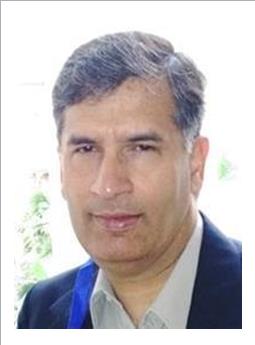
Location: Ramallah, Palestine. As I was working on my laptop in my hotel room, I heard a knock on the door. Raising my voice, I said, “Coming.â€Â I guess the person at the door must have heard my shout as “Come in.â€Â I heard the sound of unlocking of my door and there was this young man — a room service staff with his service cart. He started talking to me in Arabic.
I am used to being mistaken for a local; many Indians can be easily mistaken for Palestinian. Palestine has a broad range of skin tones and facial features — some as white as Caucasians, and as dark as Africans. In fact, in the city of Jericho I had a déjà vu. The restaurant manager, where I had my lunch, reminded me of a service staff at the Rama Krishna Vegetarian Restaurant I used to frequent during my junior college days in Vile Parle, Bombay.
For the moment then, I was really transported down memory lane to my school/junior-college days. I thought, maybe the service staff had immigrated here and opened a restaurant in Jericho. But, wait! There was no Dosa, Idli, Vada or Uttapam on the menu. And, how come the person had not aged a bit in nearly those 40 years!
Going back to the service staff who had just entered my room, he hardly spoke any English. I had a difficult time explaining to him that there was no need to change the bathroom towels or bed sheets — the environmentalist in me cannot accept the wasteful extravagance. I really wanted him to just clean up the coffee cup, get rid of the used tea bags, sugar packets, etc. We were both speaking words — I, English and he, Arabic. But, the real communication was occurring through gestures, facial expressions, and actions. I could sense a disbelief in his eyes — how come this man cannot speak Arabic? Not counting the several OKs he had uttered so far, I finally heard him say two English words: “You where?â€
Ahh…so,he wanted to know where this man was from — the Arab-looking man who cannot speak Arabic. I did not want to confuse him further and decided not to say that I am from the USA—the country that I claim to be mine and where I have been living for the last 32 years. Instead, I told him that I was from India — the country of my birth.
His face brightened instantly. “INDIA! Al Hindi!†he exclaimed! His eyes lit up. He followed it up with the brightest, heart-warming smile and profusely said, “Welcome!  Welcome!!†and a few more Arabic words. “Welcome, Welcome…Welcome!â€Â He was genuinely happy to know that I am from India.
What followed then was something I should have expected as I had a similar experience in my hotel room in Morocco last year. I was trying to be out of the way of the hotel service staff — sitting on a chair in one corner of the room with my laptop, so that he could make my room up efficiently — he continued talking with excitement. I could hear a mix of Arabic words and names of Hindi movies/actors. Jab We Met…Kareena Kapoor… a few more Arabic words… Salman Khan…Shah Rukh Khan…Jab Tak Hai Jaan… more Arabic words. I smiled and nodded to acknowledge his mentioning of several popular Hindi movies and actors.
After making up my room, the hotel staff at my Ramallah hotel welcomed me to Palestine three more times while leaving the room. I was really moved by his love and excitement.
I decided to take a break. I went to the bed, turned the TV on and switched the channel from CNN International to Channel 645—Zee AFLAM. It was showing Oye Luckey, Luckey Oye, starring Abhay Doel.
I couldn’t follow the movie dubbed in Arabic, but I continued watching it. That was the least I could do to thank Bollywood for getting me so much affection and love in many parts of the world.
“Thank you, thank you and thank you Bollywood! Shukran from the bottom of my heart!â€
Note: The Shukran is the same as the Hindi shukriya or the English Thank you.  ♣
Home
The Silk Screen Festival’s 10th Annual Gala
By Nandini Mandal, Pittsburgh, PA
e-mail:Â rinkoo1970@gmail.com
The Silk Screen Film Festival completes ten years this year. Nandini Mandal of the Nandanik Dance Academy talked to Harish Saluja, the dynamo behind the festival, on his exciting and sometime exhausting roller coaster journey in these ten years. The freewheeling interactions took place over dinner at the Bravo Cucina in the Galleria in South Hills in May.

Nandini Mandal talking to Harish Saluja over dinner for the interview. Graphics: Â Alisa Jaconson of Silk Screen Asian Arts.
A young engineering student from IIT Kharagpur biked all the way to the suburbs of Kharagpur to watch Satyajit Ray’s Bengali movie Teen Konya (Three Women). Ray’s movies, unlike popular Hindi potboilers of that era, did not have the hero or the heroine break out into song or dance every half hour or melodramatic endings; nor did they have the gloss and glamour associated with the Bombay film industry, before it became Bollywood. Termed a pioneer in the parallel film industry, Ray’s movies were often considered “Art Films,†winning awards and accolades all over the world, but not always at the box office.
The young engineering student returned to his hostel that night — and to his surprise, found himself drawn towards the same theater the next day, and the next. There was something about that genre of storytelling that drew him back to the South Institute Theater at Kharagpur, and also drove him to learn Bengali so as to understand the nuances of the movies better. It also was the beginning of a new madness for him — Movies. He dreamt of making movies one day. And he did.
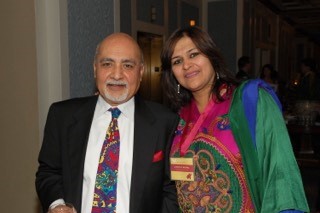
Harish with Sumedha Nagpal, a volunteer with Silk Screen.
That was Harish Saluja, as most of us know him in the greater Pittsburgh region, who also has been running the Music of India radio program with his friend Vijay Bahl for over 30 years now. Saluja loves films, and anything associated with the movie business. It was this ardent passion for films that has given Pittsburgh, and Western PA, The Silk Screen Film Festival, showcasing Asian and Asian-American films from around the world.
As the Silk Screen Festival celebrates its tenth year this year, The Pittsburgh Patrika, wanted to have a candid conversation with the man-behind-the lens — Saluja himself — about his journey in pursuing his passion from conceptualization to its realization, and the future of the festival in the years ahead.
In his usual casual, yet lively and vivacious style, which is natural to him, Saluja led us down his memory lane, starting with What was it that triggered the idea of hosting a film festival?
When he arrived in the USA in the early nineteen-seventies, like most of his generation, he was often surprised that there was so much ignorance about India and Asia among people in the American mainstream. In disbelief, he recalls, “It remained unchanged for a very long time. Among those in the US mainstream, hardly anyone knew about Tyagaraja, Tagore, Nehru, or Ray. There was a dearth of information about the rich cultural heritage of the Indian subcontinent.â€
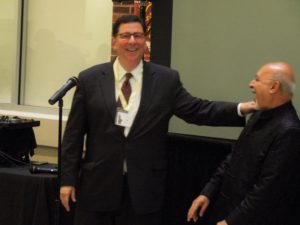
Pittsburgh’s Mayor Bill Peduto cracking a Joke with Harish Saluja.
Saluja remembers how his parents would define and differentiate artists from each other: “I remember my father telling me once, ‘Getting a salary, paying bills, building a house are all equivalent to brushing one’s teeth — nothing out of this world. Everyone has to do it. But giving something to society is different.’
“I remember how my mother would get excited when an artist – whether it was a poet, or a singer, or an instrumentalist visited our house. She kept no stones unturned to ensure that her special guests received the best treatment; and that her son — that’s me — recited his best poem before the guests. And all because they were artists who contribute more than others to the world.â€
Harish, an engineer by profession, and an artist and a musician by hobby, entered into filmmaking out of passion. In retrospect, Harish now thinks, one of his American friends unknowingly started the ball rolling. She told him, “Harish, you know art, you know music, you love films. Why don’t you start something that will help promote your culture to the western world?â€
He had also understood that although Pittsburgh was modern culturally, the city had failed to embrace new immigrants, mostly from Asia. He then quoted Richard Florida who authored Rise of the Creative Class: “People go to places where their lifestyle would be valued.â€
Harish ruefully told me, “There is a Columbus Day parade in Pittsburgh, but there is no Chinese New Year celebration, and the city does not celebrate India Day.â€

Sally Wiggins, the anchor at WTAE has been supporting Silk Screen as the emcee of the gala.
Then 9/11 happened. Soon there were incidents of mistaken identity — murders of innocent Sikhs who were shot mistaken for Muslims because of their beards and turbans, when, ironically, most Muslims in the US neither wear turbans nor have beards. This goaded him to do something that could make mainstreamers understand Asia and Asians a little better. Having a film background made it an easy decision for him.
He told himself, “It has to be a film festival.†Thus was born The Silk Screen Asian American Film Festival. The name is a play on the phrases silver screen and silk route — defining the genre of movies to be shown at the festival.
When Harish approached Ed Rendell, then governor of Pennsylvania, he got $15,000 in seed money to help start the festival. He continues: “Various foundations, when approached, were very generous. The first festival targeted 500 people to come to the festival. But we were overwhelmed when over 2000 filmgoers came. It was a smashing success, and a great start. There were recognitions and mention internationally. From there, it was no looking back.â€
Saluja and his board of directors, advisors and team of dedicated volunteers decided to expand the festival so that it reached more people in the greater Pittsburgh area itself. It occurred to them that it helped improve the cultural tourism of Pittsburgh and helped bring in the money from the Governor. (This money has since stopped.)
A team of 30 to 40 volunteers from all backgrounds work hard to make the festival a success right from the red carpet gala night to sellin
g tickets. “We were invited by schools, colleges, and museums as this was a great way of showcasing Asian culture and diversity,†he said, and continued: “It was a good medium to educate children about Asian American culture. Then, in association with a few jazz musical geniuses, we formed the Silk Band that had played at the festival in recent years.†As an aside, Harish gleefully mentioned that the Silk Band was invited to play at Peduto’s Mayoral inaugural.
Harish continues: “Collecting funds to bring and showcase films at theaters, host the directors and actors is a Himalayan task. So financially, the road has not been very smooth in the ten years. To give you some idea, typically, 25% of the funds come from foundations, 50% from corporate sponsors. Only the remaining 25% is from individual donations and ticket sales.â€
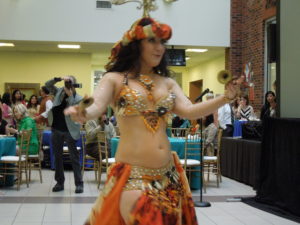
Live performances at the gala.
There have been all types of constraints all along. Changing times and the ups and downs in the economy are making it more difficult for Harish and his team. But the financial constraint is a big one. Says Harish, “The foundations have all cut back on their funding, and the governor’s fund has dried up altogether. The foundations who helped enthusiastically to start the festival, now expect the Festival to become financially self-sustaining.â€
Understandably, with the professional and economic success of Asians in the region getting wide coverage in the media, the big-name donors also expect the festival to get more financial support from the Asian community in Pittsburgh.
Harish does not hide his disappointments: “However, Asian communities have provided very little support for the festival in general. Indians, Chinese, Koreans, Middle-Eastern communities and organizations have not come forward so far to help and financially support and promote the festival, despite the festival showcasing again and again films from Iran, India, Pakistan, Turkey, South Korea, Japan, China, and Malaysia among many other Asian countries. Why is this so? That is something for all Asians to ponder.â€
That Pittsburgh is not a glitzy city compared to Cannes, Venice, Toronto, Singapore, London, Chicago, New York, LA, San Francisco, or Miami, also does not help Harish. He contritely says, “We are not able to attract even tourists to Pittsburgh, nationally or internationally despite the picturesque cityscape surrounded by meandering rivers and hills and countless bridges.â€
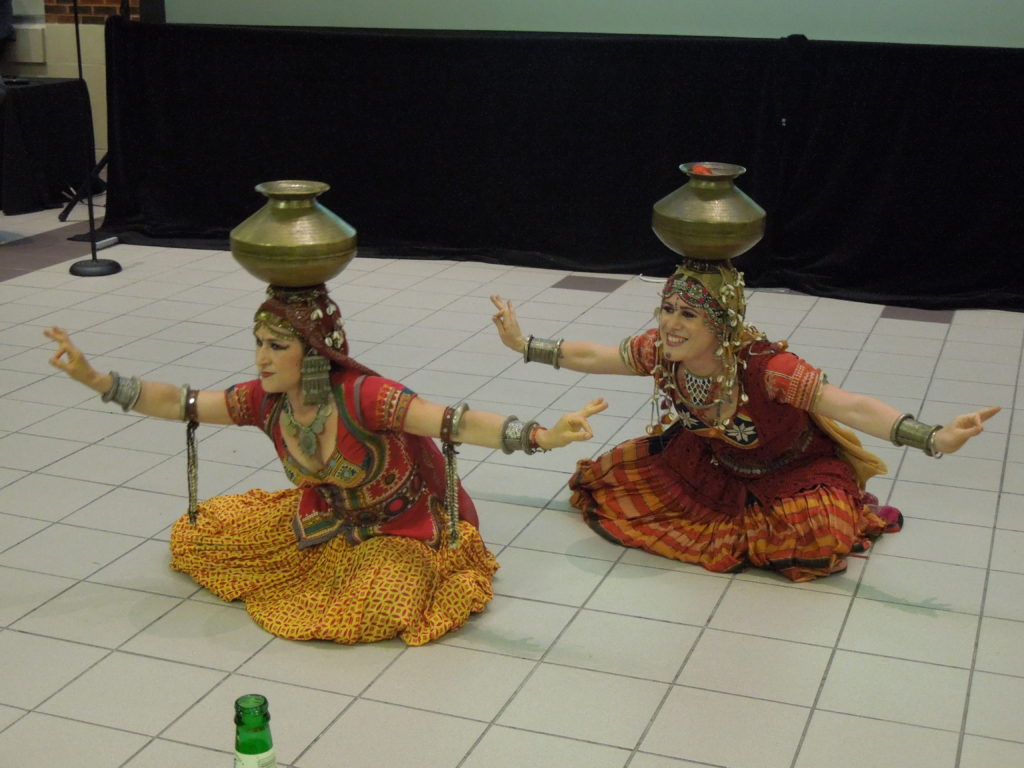
One of the many live performances at the gala.
Understandably, film makers would rather take their creations to festivals that offer awards and award money than come to a city merely to present their movies. Many of his fellow film makers and friends based in London or India say, “Look, we like you, but what would you do if you had a chance to go to a famous festival?†Most film makers want to go to a big-name festival, win an award, get publicity, sell the film, and move on.
The other huge challenge plaguing the festival that outsiders never realize is the rampant piracy of movies in the Indian subcontinent. “Why would one pay to go to a movie that can be seen for free on YouTube or Einthusan on the day of the release?†Harish rhetorically asks.
Amidst these many challenges, the festival is completing its tenth year. Where does Saluja plan to go from here? He is emphatic: “I would like to see more panel discussions or Q&A sessions with actors and directors. The Festival is moving to September this year from its May schedule so that more university students can participate and add verve and energy. This year, films will be showcased at multiple venues across the city — at Regent Square, the Carnegie Museum, the Water Works Mall, the University of Pittsburgh and Carnegie Mellon University.â€
As our freewheeling exchanges winded down, Saluja sounded optimistic: “The festival has evolved into a Pittsburgh tradition and will continue for years to come. The silver screen that takes the audience on a journey through the Silk Route will continue to enthrall thousands.â€
Join The Patrika in congratulating Harish Saluja and his fantastic team on their decade-long journey on this timeless Silk Route, and wishing him many more of these annual gala.
So, come September, “Lights, Camera, Action,†for the festival.   ♣
Home
Taken for Granted
Juginder Luthra, Pittsburgh, PA
Editor’s note: Juginder Luthra wrote this free-style poem based on the vistas of Pittsburgh during day and night including activities on Grandview Avenue. It ends with an eclectic and sophisticated twist, drawing a parallel on how we look at life.
From the balcony, views of Pittsburgh
Awesome, breathtaking, out of this world

Tall varied textured buildings lit bright
Some days soaked in golden sunshine
Embraced at night by fog or moon light
Lip-locked lovers, walkers, bicyclists,
Zippy kids, the old and frail
People throng Viewpoints,
fill benches, line along walking trail
They come hooded, bundled in the thick of freezing winter
Rain gear covered in downpour; bare-chested in summer
Limos dot along Grandview Avenue for special occasion
People arrange festivities for birthdays, weddings or just fun
Great view of town in the Burgh, one of best in the country
Visitors throng from far and near, ranging poorest to highest gentry.

Two beautiful rivers, like two lovers, eager to meet
Where Spring kisses the ground;
Merge, mingle into the Mighty One,
Fountain witnesses new life just begun
With every passing day the thrill of view gets dim and jaded
Starry lights not as bright,
evenings same old dull-’n-faded
Visitors wish for a higher floor for better views and open sky;
Some with acrophobia complain,
wish it was not sickening high.
My nemesis is PPG building;
It blocks flowery dancing fireworks
Its shining glass pillars no longer a marvel to relish
Only draw frowns and smirks.
Monongahela no longer shimmering blue; its water dull, murky brown
Train’s whistle and noise causes conversations to drown.
The Point with its fountain just a sticking finger of land,
Jutted between two rivers where the new one just began.
Days go by haven’t opened the drapes to get a peek
Nothing special happening, the Mon just another creek
Similarly, life gets taken for granted
Our breath, beating heart, ears and eyes,
Every cell working smoothly, non-stop
On demand, without even being asked
Body beautiful gets taken for granted
Miracles of Nature no longer evoke wonder or praised.
Shortcomings, faults, blemishes  are noted
Plastic surgeons, psychiatrists, hospitals kept occupied
Even makers of our body – our parents — forgotten,
often cursed, many a time.
One wrong gene passed among thousands of perfect ones
become actors in crime
Nature or God — whatever or whoever we believe in,
Not thanked, remembered, or acknowledged and now forgotten
Everything gets taken for granted.
Only pitfalls highlighted to grumble and whine.
Complaints take the front stage, highlighted to shine
Views of the Burgh,
Miracles of nature and life
All, with passage of time,
Get taken for granted.
Note: Dr. Kamlesh Aggarwal, a friend of the Luthras, shot the two pictures from the balcony of their condo on Grandview Ave. at different times of the day. The picture at the beginning of the poem was used on the cover of the July issue of the magazine —.  ♣
Home
Funds Raised for 200 EKAL Vidyalaya Schools
 By Jayashree Phanse, Presto, PA
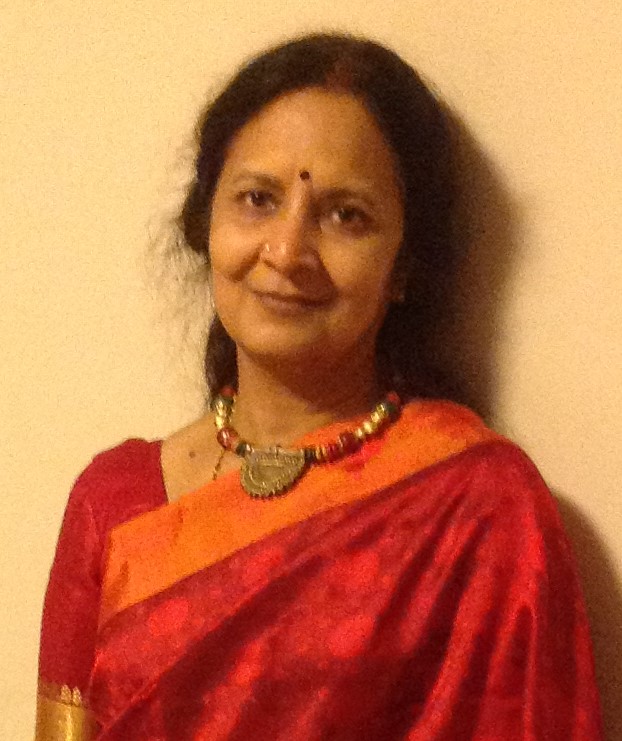 Jayashree, a resident of Pittsburgh for over three decades, is well-known within the Indian community because of her association with the temples and cultural activities. She was a high school teacher in Oakland teaching science, math and computers. She enjoys singing and listening to songs in Indian languages, golfing and social work.
Jayashree, a resident of Pittsburgh for over three decades, is well-known within the Indian community because of her association with the temples and cultural activities. She was a high school teacher in Oakland teaching science, math and computers. She enjoys singing and listening to songs in Indian languages, golfing and social work.
Taking Swami Vivekananda’s exhortation, “If the poor child cannot come to education, then education must go to the child,†to their heart, the EKAL Vidalia Foundation (Foundation of Schools with Single Teacher) has been striving to develop the villages by taking education to interior and tribal India. With the easily achievable goal of frugal literacy for $1/day, EKAL raises funds for training one teacher for a class of 20 to 30 children in the poorest regions of the country.
For raising funds, EKAL organizes concert tours with talented artists from the vibrant Indian TV’s reality shows in different cities of USA. This year’s artistes from Anand Dhun-Anand Swar — Anand Vinod, Vibhavari with Raj Parmar on the keyboard, Dhirendra Dave on the tabla and J. Natu on octapad performed at the Chartier Valley Intermediate School Auditorium on April 30, 2016 with over 500 in the audience. They performed in over 60 cities in the US.
The program started on time with a Saraswati Puja and Moha Desai nicely rendering the Sarawati Dwadasha Naama Stotra. This was followed by Shree Ganeshaya Dheemahi, and the Ekal theme song.
The artists had started their day at 5:30 am to take morning flight, but with the flight getting canceled, they ended up being driven by volunteers from New Jersey, arriving just half hour before the start of the program, with barely any time even to refresh themselves.
Anand Vinod is considered to be one of the Top-10 singers of Kishore Kumar songs. We had to just close our eyes and hear Kishore Kumar coming alive through Anand Vinod. It was indeed a great treat for the diehard fans of this great Bollywood legend. Anand also rendered Mohammad Rafi songs to entertain the Rafi fans as well.
Vibhavari Yadav, the winner of SaReGaMaPa Gujarat 2014 and the Nightingale award in Gujarat, with her pleasant, soothing voice, did not seem one bit tired after almost three hours of singing. Vibhavari presented film songs covering a range of moods sweeping the audience away with her melodies.
Raj Parmar was not only versatile on the key board but was also a good singer. He participated with the lead singers in presenting several songs including duets and group songs. His humorous quips kept the audience attentive in the gaps between the songs. J Natu on the Octapad also sang a smooth song by Mukesh and gave us a short drift in the main show. I must add that Dhirendra Dave’s tabla talent added zest to the program.
There was a short informative video presentation during the intermission filled giving an overview of the EKAL Abhiyaan movement. It was packed with information, taking us from the birth of EKAL through their 26-yeal long journey. Extending itself beyond taking schools to the children and youth, EKAL tries to empower rural families using literacy holistically, on farming issues, health and hygiene, alcohol abuse. India’s Prime Minister Shri Narendra Modi recognized EKAL for having trained more than 52000 teachers educating more than 1.5 million children throughout the remote areas of the country.
The younger generation of Pittsburgh is also donating to this cause, recognizing that the education they have received is a privilege and not a birthright. On this day EKAL received donations for more than 200 schools.
Amazon Shoppers can also participate by choosing EKAL as their choice charity at smile.amazon.com. The entertainment continued till about 11 pm and ended with the Jana Gana Mana displaying the Patriotic element in EKAL.
The first EKAL in Pittsburgh in 2004 conducted at the Hindu Jain Temple with 75 people in the audience and raised money for five schools. This year, funds were raised for more than 200 schools, each receiving $365. Ekal’s Pittsburgh supporters have come a long way.  ♣
